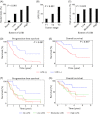Significance of lymphovascular space invasion in epithelial ovarian cancer
- PMID: 23342265
- PMCID: PMC3544453
- DOI: 10.1002/cam4.31
Significance of lymphovascular space invasion in epithelial ovarian cancer
Abstract
While the prognostic significance of lymphovascular space invasion (LVSI) is well established in endometrial and cervical cancer, its role in ovarian cancer is not fully understood. First, a training cohort was conducted to explore whether the presence and quantity of LVSI within the ovarian tumor correlated with nodal metastasis and survival (n = 127). Next, the results of the training cohort were applied to a different study population (validation cohort, n = 93). In both cohorts, histopathology slides of epithelial ovarian cancer cases that underwent primary cytoreductive surgery including pelvic and/or aortic lymphadenectomy were examined. In a post hoc analysis, the significance of LVSI was evaluated in apparent stage I cases (n = 53). In the training cohort, the majority of patients had advanced-stage disease (82.7%). LVSI was observed in 79.5% of cases, and nodal metastasis was the strongest variable associated with the presence of LVSI (odds ratio [OR]: 7.99, 95% confidence interval [CI]: 1.98-32.1, P = 0.003) in multivariate analysis. The presence of LVSI correlated with a worsened progression-free survival on multivariate analysis (hazard ratio [HR]: 2.06, 95% CI: 1.01-4.24, P = 0.048). The significance of the presence of LVSI was reproduced in the validation cohort (majority, early stage 61.3%). In apparent stage I cases, the presence of LVSI was associated with a high negative predictive value for nodal metastasis (100%, likelihood ratio, P = 0.034) and with worsened progression-free survival (HR: 5.16, 95% CI: 1.00-26.6, P = 0.028). The presence of LVSI is an independent predictive indicator of nodal metastasis and is associated with worse clinical outcome of patients with epithelial ovarian cancer.
Keywords: Lymph node metastasis; lymphovascular space invasion; ovarian cancer; survival.
Figures



References
-
- Siegel R, Naishadham D, Jemal A. Cancer statistics, 2012. CA Cancer J. Clin. 2012;62:10–29. - PubMed
-
- Hennessy BT, Coleman RL, Markman M. Ovarian cancer. Lancet. 2009;374:1371–1382. - PubMed
-
- Hachisuga T, Kaku T, Fukuda K, Eguchi F, Emoto M, Kamura T, et al. The grading of lymphovascular space invasion in endometrial carcinoma. Cancer. 1999;86:2090–2097. - PubMed
-
- O'Brien DJ, Flannelly G, Mooney EE, Foley M. Lymphovascular space involvement in early stage well-differentiated endometrial cancer is associated with increased mortality. BJOG. 2009;116:991–994. - PubMed
-
- Tsuruchi N, Kaku T, Kamura T, Tsukamoto N, Tsuneyoshi M, Akazawa K, et al. The prognostic significance of lymphovascular space invasion in endometrial cancer when conventional hemotoxylin and eosin staining is compared to immunohistochemical staining. Gynecol. Oncol. 1995;57:307–312. - PubMed
MeSH terms
LinkOut - more resources
Full Text Sources
Medical

